House of Glücksburg
| House of Glücksburg | |
|---|---|
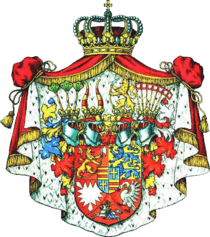 | |
| Country |
|
| Parent house | House of Oldenburg |
| Titles | |
| Founded | 6 July 1825 |
| Founder | Friedrich Wilhelm |
| Current head | Christoph |
The House of Glücksburg (shortened version of the House of Schleswig-Holstein-Sonderburg-Glücksburg; Danish: Slesvig-Holsten-Sønderborg-Lyksborg, also spelled -Glücksborg), is a German ducal house.
Junior branches of the House include the royal houses of Denmark, Norway, and Greece. The Prince of Wales, who is the heir apparent to the thrones of the United Kingdom and the other Commonwealth realms,[1][2] belongs officially to the House of Windsor,[3] but also belongs to a cadet branch of the House of Schleswig-Holstein-Sonderburg-Glücksburg.
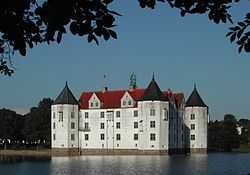
History
The House is named after Glücksburg, a small coastal town in northernmost Germany near the Danish border. It is itself a cadet branch of the House of Oldenburg, that is descended from Count Christian of Oldenburg, who became King of Denmark in 1448 and King of Norway in 1450. As the original House of Oldenburg and the House of Schleswig-Holstein-Sonderburg-Augustenburg became extinct in 1863 and 1931, respectively, the House of Glücksburg is now the senior surviving branch of the House of Oldenburg.
The House descends patrilineally from the Dukes of Schleswig-Holstein-Sonderburg-Beck. The last of them became Duke of Glücksburg and changed his title accordingly to Friedrich Wilhelm, Duke of Schleswig-Holstein-Sonderburg-Glücksburg. He was married to Princess Louise Caroline of Hesse-Kassel, a granddaughter of King Frederick V of Denmark of the House of Oldenburg.
Neither the Dukes of Beck nor of Glücksburg were sovereign rulers; they held their lands in fief to the sovereign Dukes of Schleswig and Holstein, i.e. the Kings of Denmark and, before 1773, the Dukes of Holstein-Gottorp.
Christian of Schleswig-Holstein-Sonderburg-Glücksburg, the fourth son of Duke Friedrich Wilhelm, was chosen by the childless King Frederick VII of Denmark to be his heir, as Christian was married to Frederick's first cousin, Luise of Hesse-Kassel. He became King of Denmark as Christian IX on 15 November 1863.
Wilhelm, the second son of Crown Prince Christian and Crown Princess Luise, was elected King of the Hellenes on 30 March 1863 to succeed the deposed Wittelsbach Otto of Greece and took the name George I of Greece.
Prince Carl, the second son of Frederick VIII of Denmark, Christian IX's eldest son, became King of Norway on 18 November 1905 as Haakon VII of Norway.
Christian IX's daughters, Alexandra of Denmark and Dagmar of Denmark (who became Maria Feodorovna), married Edward VII of the United Kingdom and Alexander III of Russia, respectively. As a result, by 1914, descendants of King Christian IX were more prevalent on European thrones than those of Queen Victoria 5–2; Christian IX became known as the Father-in-law of Europe.
Patrilineal ancestry of Duke Friedrich Wilhelm
- Elimar I, Count of Oldenburg
- Elimar II, Count of Oldenburg
- Christian I, Count of Oldenburg (Christian the Quarrelsome)
- Maurice, Count of Oldenburg
- Christian II, Count of Oldenburg
- John I, Count of Oldenburg
- Christian III, Count of Oldenburg
- John II, Count of Oldenburg
- Conrad I, Count of Oldenburg
- Christian V, Count of Oldenburg
- Dietrich, Count of Oldenburg
- Christian I of Denmark
- Frederick I of Denmark
- Christian III of Denmark
- John II, Duke of Schleswig-Holstein-Sonderburg
- Alexander, Duke of Schleswig-Holstein-Sonderburg
- August Philipp, Duke of Schleswig-Holstein-Sonderburg-Beck
- Frederick Louis, Duke of Schleswig-Holstein-Sonderburg-Beck
- Peter August, Duke of Schleswig-Holstein-Sonderburg-Beck
- Karl Anton August, Prince of Schleswig-Holstein-Sonderburg-Beck
- Friedrich Karl Ludwig, Duke of Schleswig-Holstein-Sonderburg-Beck
- Friedrich Wilhelm, Duke of Schleswig-Holstein-Sonderburg-Glücksburg
Germany
Duke of Schleswig-Holstein-Sonderburg-Glücksburg

The Dukes of Schleswig-Holstein-Sonderburg-Glücksburg constitute the senior male line of the family, who hold the headship of both the House of Glücksburg and the entire House of Oldenburg.
| Portrait | Name | Life | Reign |
|---|---|---|---|
 |
Friedrich Wilhelm, Duke of Schleswig-Holstein-Sonderburg-Glücksburg | 1785–1831 | 1825–1831 |
 |
Karl, Duke of Schleswig-Holstein-Sonderburg-Glücksburg | 1813–1878 | 1831–1878 |
.jpg) |
Friedrich, Duke of Schleswig-Holstein-Sonderburg-Glücksburg | 1814–1885 | 1878–1885 |
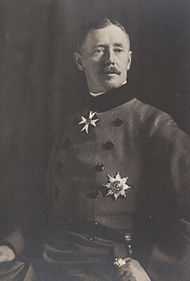 |
Friedrich Ferdinand, Duke of Schleswig-Holstein | 1855–1934 | 1885–1934 |
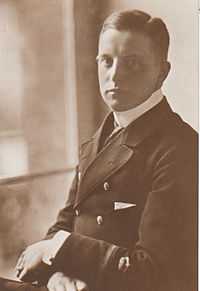 |
Wilhelm Friedrich, Duke of Schleswig-Holstein | 1891–1965 | 1934–1965 |
| Peter, Duke of Schleswig-Holstein | 1922–1980 | 1965–1980 | |
| |
Christoph, Prince of Schleswig-Holstein | 1949– | 1980– |
The heir apparent is Friedrich Ferdinand, Hereditary Prince of Schleswig-Holstein (b. 1985).
Denmark
King of Denmark
In 1853, Christian, Prince of Schleswig-Holstein-Sonderburg-Glücksburg was heir to the Kingdom of Denmark, and in 1863, he ascended the Throne. His father was Friedrich Wilhelm, Duke of Schleswig-Holstein-Sonderburg-Glücksburg.
| Portrait | Name | Life | Reign | Additional titles |
|---|---|---|---|---|
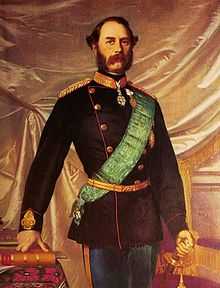 |
Christian IX of Denmark | 1818–1906 | 1863–1906 | King of the Wends King of the Goths Duke of Schleswig, Holstein, Stormarn, Dithmarschen, Lauenburg and Oldenburg Prior to acceeding the throne: Prince of Schleswig-Holstein-Sonderburg-Glücksburg (Danish: Prins af Slesvig-Holsten-Sønderborg-Glückborg) |
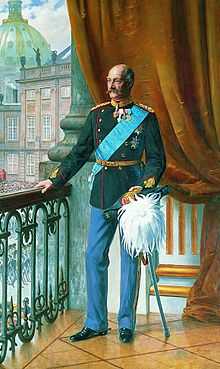 |
Frederick VIII of Denmark | 1843–1912 | 1906–1912 | King of the Wends King of the Goths Duke of Schleswig, Holstein, Stormarn, Dithmarschen, Lauenburg and Oldenburg |
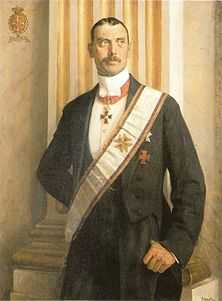 |
Christian X of Denmark | 1870–1947 | 1912–1947 | King of Iceland (used 1918–1944) King of the Wends King of the Goths Duke of Schleswig, Holstein, Stormarn, Dithmarschen, Lauenburg and Oldenburg |
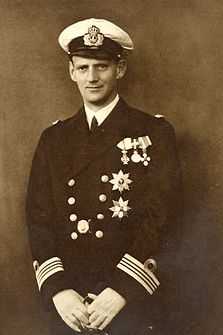 |
Frederick IX of Denmark | 1899–1972 | 1947–1972 | King of the Wends King of the Goths Duke of Schleswig, Holstein, Stormarn, Dithmarschen, Lauenburg and Oldenburg |
 |
Margrethe II of Denmark | 1940– | 1972– |
The heir apparent is Frederik, Crown Prince of Denmark (b. 1968), who belongs patrilineally to the House of Monpezat. See the present line of succession.
Count of Rosenborg
Younger princes have received the noble title of Count of Rosenborg with the style His Excellency.
Greece
King of the Hellenes
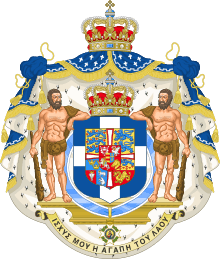

In 1863 and with the name George I, Prince Wilhelm of Denmark became King of the Hellenes. His father was King Christian IX of Denmark.
| Portrait | Name | Life | Reign | Additional titles |
|---|---|---|---|---|
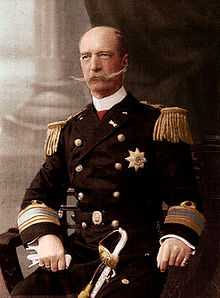 |
George I of Greece | 1845–1913 | 1863–1913 | Prince of Denmark Prince of Schleswig-Holstein-Sonderburg-Glücksburg |
 |
Constantine I of Greece | 1868–1923 | 1913–1917 1920–1922 |
Prince of Denmark Prince of Schleswig-Holstein-Sonderburg-Glücksburg |
 |
Alexander of Greece | 1893–1920 | 1917–1920 | Prince of Denmark Prince of Schleswig-Holstein-Sonderburg-Glücksburg |
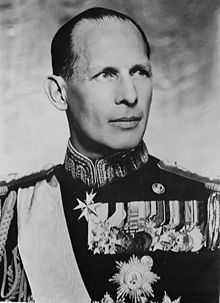 |
George II of Greece | 1890–1947 | 1922–1924 1935–1947 |
Prince of Denmark Prince of Schleswig-Holstein-Sonderburg-Glücksburg |
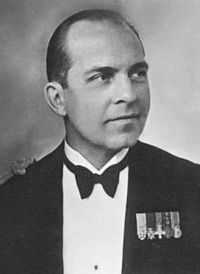 |
Paul of Greece | 1901–1964 | 1947–1964 | Prince of Denmark Prince of Schleswig-Holstein-Sonderburg-Glücksburg |
 |
Constantine II of Greece | 1940– | 1964–1973 | Prince of Denmark Prince of Schleswig-Holstein-Sonderburg-Glücksburg |
- Titular
| Portrait | Name | Life | Reign | Additional titles |
|---|---|---|---|---|
 |
Constantine II of Greece | 1940– | 1973– | Prince of Denmark Prince of Schleswig-Holstein-Sonderburg-Glücksburg |
The heir apparent is Pavlos, Crown Prince of Greece (b. 1967). See the present line of succession
Norway
King of Norway
In 1905 and with the name Haakon VII, Prince Carl of Denmark became King of Norway. His father was King Frederick VIII of Denmark, and one of his uncles was King George I of Greece.
| Portrait | Name | Life | Reign | Additional titles |
|---|---|---|---|---|
 |
Haakon VII of Norway | 1872–1957 | 1905–1957 | Prince of Denmark Prince of Schleswig-Holstein-Sonderburg-Glücksburg |
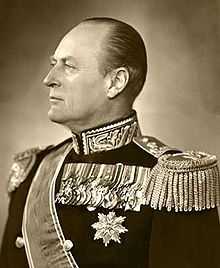 |
Olav V of Norway | 1903–1991 | 1957–1991 | Prince of Denmark Prince of Schleswig-Holstein-Sonderburg-Glücksburg |
.jpg) |
Harald V of Norway | 1937– | 1991– | Prince of Denmark Prince of Schleswig-Holstein-Sonderburg-Glücksburg |
The heir apparent is Crown Prince Haakon of Norway (b. 1973). See the present line of succession.
Iceland
King of Iceland
In 1918, Iceland was elevated from an autonomous Danish province to an separate Kingdom of Iceland. King Christian X of Denmark was henceforth King of Denmark and Iceland. This lasted until 1944, when Iceland dissolved the union between the two countries. Christian X was the only monarch to hold a distinct Icelandic title, and used the same CX cypher and the same regnal number as in Denmark.
| Portrait | Name | Life | Reign | Additional titles |
|---|---|---|---|---|
 |
Christian X of Iceland | 1870–1947 | 1918–1944 | King of Denmark King of the Wends King of the Goths Duke of Schleswig, Holstein, Stormarn, Dithmarschen, Lauenburg and Oldenburg |
The heir apparent was his son Frederick IX of Denmark (1899–1972).
Great Britain and Northern Ireland
Duke of Edinburgh

In 1947, Philip of Schleswig-Holstein-Sonderburg-Glücksburg, Prince of Greece and of Denmark (who relinquished all his titles and adopted the surname Mountbatten), was created Duke of Edinburgh by his father-in-law, George VI of the United Kingdom. The first eleven places in the Line of succession to the British throne are held by descendants of the Duke of Edinburgh.
| Portrait | Name | Life | Reign | Additional titles |
|---|---|---|---|---|
 |
Philip Mountbatten, Duke of Edinburgh[2] | 1921– | 1947– | Earl of Merioneth Baron Greenwich |
The heir apparent is Charles, Prince of Wales (b. 1948).[4]
Family Tree

See Also
Notes and references
- ↑ Published on Saturday 18 April 2009 20:03 (2009-04-18). "Prince Philip beats the record for longest-serving consort – News – Scotsman.com". News.scotsman.com. Retrieved 2012-09-06.
- ↑ 2.0 2.1 Michel Huberty, L'Allemagne dynastique, Volume 7, Giraud, 1994, ISBN 2-901138-07-1, ISBN 978-2-901138-07-5
- ↑ Francois Velde. "Royal Styles and Titles – 1960 Letters Patent". Heraldica.org. Retrieved 2012-09-06.
- ↑ Whilst the letter patent states that the Dukedom is to be inherited by the (eldest) heir male of the body lawfully begotten, i.e. by the current Prince of Wales, it was announced in 1999 that Prince Edward, Earl of Wessex, i.e. a younger brother of the Prince of Wales, would follow his father as Duke of Edinburgh. Pending changes to that effect, the Prince of Wales is currently the heir apparent according to the letter patent.


